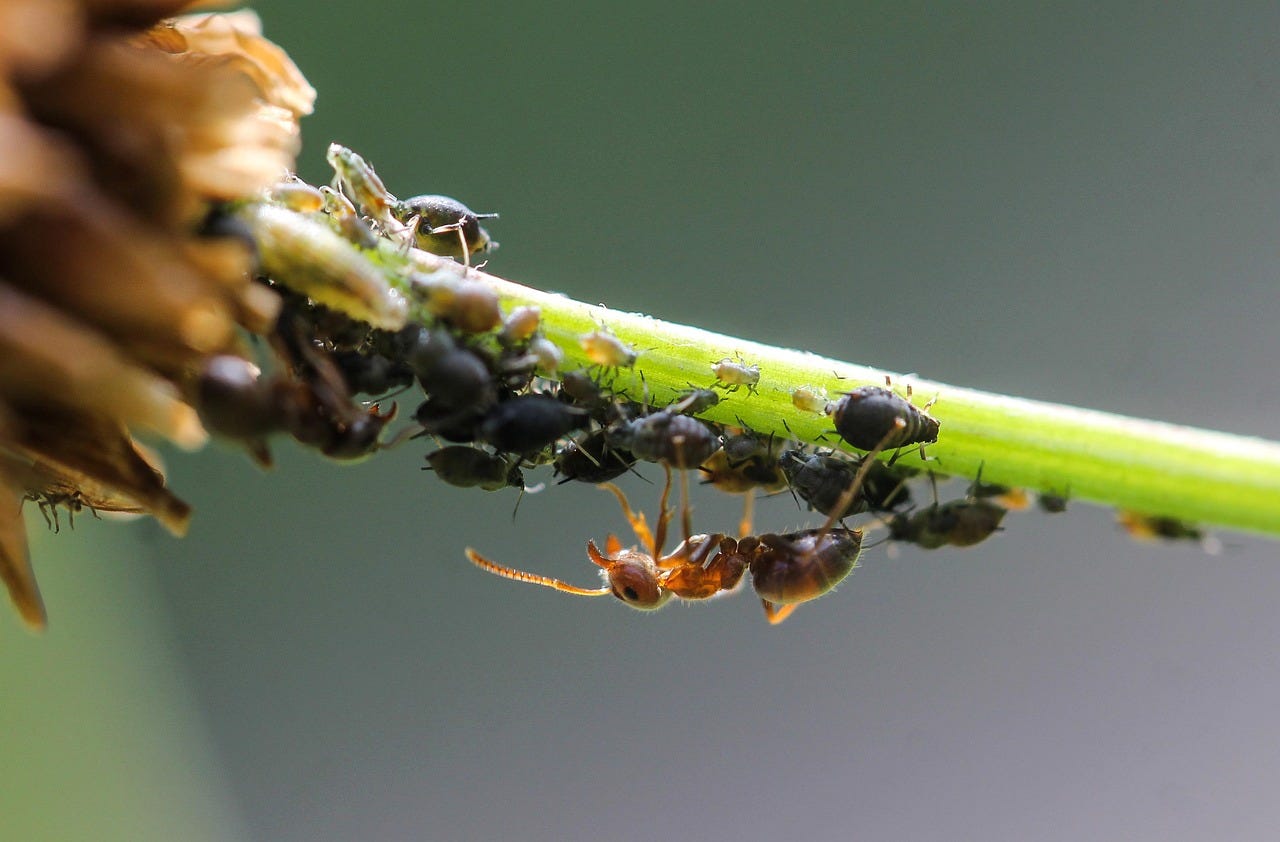Pest problems?
the Permaculture hierarchy of intervention
Permaculture design aims to create robust, resilient, and complex systems. When faced with so-called ‘pests’, we turn to our 'hierarchy of intervention'.
This is a step-by-step approach and goes from 1 to 4 depending on the severity of the ‘problem’ and the extent and duration of crop damage.
1. Do nothing, observe, if the design has been correctly done and includes a wild zone, as they all should, pest predators should arrive and regulate the 'pest'.
2. Manual or mechanical intervention, crop damage continues to increase. Remove pests manually to reduce the population, but don't try to eliminate them; leave some to attract predators. If possible, consider introducing an animal that can assist you with this task. The overall design will have to be re-examined, it should be that the 'pest' problem arises from a lack of maturity/complexity in the system. As the system continues to evolve, it should become more complex and auto-regulated.
3. Use treatments that are permitted in organic production. Use as little as possible. A fundamental re-examination of the overall design will be required.
4. Use synthetic chemicals, if and only if crop loss could lead to a famine. Make sure that they are the least poisonous ones and use as little as possible. This is only ever the case when 1, 2, and 3 have failed. A fundamental re-examination of the overall design will be required.
Let’s take aphids as an example.
These tiny insects are responsible for major crop losses in agriculture and in our cottage gardens. They suck the plant’s sap and can be vectors for a variety of plant diseases. They encourage the growth of sooty fungi.
Do nothing, observe.
Rub them off and prevent them from being farmed by ants. Use a water jet, on strong plants, and knock the insects off.
Use ‘organic’ treatments:
Neem Oil: Acts as a repellent and disrupts aphid reproduction.
Insecticidal Soap: Mild liquid soap diluted in water can dehydrate aphids on contact.
Essential Oils: A mix of peppermint, clove, rosemary, and thyme oils in water can repel aphids.
Garlic or Hot Pepper Spray: Aphids dislike the strong scent and taste, and taste.
Tomato Leaf Spray: contains alkaloids toxic to aphids
Lack of system complexity.
As I mentioned above, we aim to design systems that will become increasingly complex and robust. It can, however, take time before there is sufficient complexity/biodiversity to deal with ‘pest’ over-abundance. This is a process we try and accelerate as much as possible. We design the system from the outset with sufficient elements to enable the whole to evolve quickly to a mature state.
People talk about how growing so-called companion plants can help. They contend that garlic, chives, onions, and marigolds repel aphids. Or that nasturtiums or cosmos lure the aphids away from the crop plants. We have found that the effects tend to be marginal and that for them to work, you need so many of these plants that there’s hardly any room for the crops.
Staying with aphids as an example:
An over-abundance of these insects means that there are insufficient numbers of their predators to control the aphid population. We don’t need an AI to work that one out!
So, who likes eating aphids? Hoverfly larvae love them, despite being blind and legless, they are voracious aphid hunters.
An overly simple way of thinking would be:
I’ve got aphids on my beans, I need hoverflies to come and control them. What can happen is that the hoverflies turn up, lay their eggs, these hatch, and the larvae help control the aphid numbers. All well and good. But the larvae have reduced the population, and other hoverflies who are wandering around looking for somewhere to lay their eggs go elsewhere. What happens then is that the aphid population rebounds.
We have to think in terms of a spatial and temporal zigzag.
We design the system in such a way that it has a diversity of ‘sacrificial’ plants. It’s best if these are perennials and shrubs work well.
The temporal bit means introducing plants that attract the hoverflies before the aphids arrive on the beans. When their larvae have reduced the population on the shrub, the hoverflies will seek elsewhere and hopefully find the growing population on the beans.
Now we get to the zigzag bit. The larvae reduce the aphid population on my beans, and the hoverflies are looking around for somewhere with a greater abundance of aphids to lay their eggs. They zig off to another shrub in the system that is covered with the prey, and lay their eggs there. The larvae reduce the shrub aphid population, and the beans have an aphid population rebound. The hoverflies zag back to the beans. We have estimated that around 7 different types of shrubs should be enough to keep the hoverflies zigzagging around the system.
In Permaculture, we observe, learn, and design in.
During the analysis part of the design process, we’ll be observing native plants. We will note which ones get infested by aphids and when this occurs. We then complete the design by including these trees and shrubs, always bearing in mind the Permaculture principles like: every element has more than one function.
Using Western Europe as an example.
Rosa canina, wild rose. They get covered with aphids. They are also multi-functional; their flowers can be used in salads or made into syrups, a popular product with visitors here. The fruit can be transformed into syrup, wine, and jam.
Sambucus nigra, elderberry. They attract aphids, and the flowers can be made into syrups, another favourite here, elderflower pressé, they can be dunked in batter and fried. The fruit is slightly toxic when raw, but makes good jam, jellies, and chutneys.
This could go on for a long time, so briefly: dogwood, hawthorn, viburnum, willow, and birch are other trees or shrubs that attract aphids and can be included in the zigzag plan.






Another great article, thanks Steve. I do like the hierarchy for pest control and other functions too e.g. fertility cycling, erosion control, etc. My perennial kales are crawling with ladybirds atm, feasting on a dwindling aphid population.
One aspect I would add is soil/plant health (could be 1 and/or 2 in the hierarchy) - healthy soil=healthy plants and vice versa which gives prevention of disease a higher priority than cure, of course. That healthy plants have their own pest avoidance resilience strategy is I believe well understood.
IPM explained beautifully and practically I will certainly be sharing this far and wide. Thanks Steve